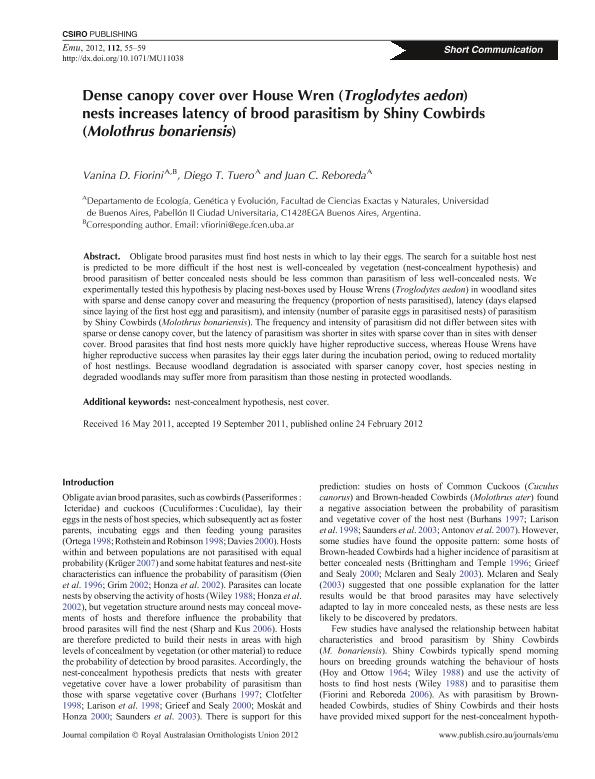Artículo
Dense canopy cover over House Wren (Troglodytes aedon) nests increases latency of brood parasitism by Shiny Cowbirds (Molothrus bonariensis)
Fecha de publicación:
02/2012
Editorial:
Csiro Publishing
Revista:
Emu
ISSN:
0158-4197
Idioma:
Inglés
Tipo de recurso:
Artículo publicado
Clasificación temática:
Resumen
Obligate brood parasites must find host nests in which to lay their eggs. The search for a suitable host nest is predicted to be more difficult if the host nest is well-concealed by vegetation (nest-concealment hypothesis) and brood parasitism of better concealed nests should be less common than parasitism of less well-concealed nests. We experimentally tested this hypothesis by placing nest-boxes used by House Wrens (Troglodytes aedon) in woodland sites with sparse and dense canopy cover and measuring the frequency (proportion of nests parasitised), latency (days elapsed since laying of the first host egg and parasitism), and intensity (number of parasite eggs in parasitised nests) of parasitism by Shiny Cowbirds (Molothrus bonariensis). The frequency and intensity of parasitism did not differ between sites with sparse or dense canopy cover, but the latency of parasitism was shorter in sites with sparse cover than in sites with denser cover. Brood parasites that find host nests more quickly have higher reproductive success, whereas House Wrens have higher reproductive success when parasites lay their eggs later during the incubation period, owing to reduced mortality of host nestlings. Because woodland degradation is associated with sparser canopy cover, host species nesting in degraded woodlands may suffer more from parasitism than those nesting in protected woodlands.
Palabras clave:
Nest Cover
,
Nest-Concealment Hypothesis
Archivos asociados
Licencia
Identificadores
Colecciones
Articulos(IEGEBA)
Articulos de INSTITUTO DE ECOLOGIA, GENETICA Y EVOLUCION DE BS. AS
Articulos de INSTITUTO DE ECOLOGIA, GENETICA Y EVOLUCION DE BS. AS
Citación
Fiorini, Vanina Dafne; Tuero, Diego Tomas; Reboreda, Juan Carlos; Dense canopy cover over House Wren (Troglodytes aedon) nests increases latency of brood parasitism by Shiny Cowbirds (Molothrus bonariensis); Csiro Publishing; Emu; 112; 1; 2-2012; 55-59
Compartir
Altmétricas




